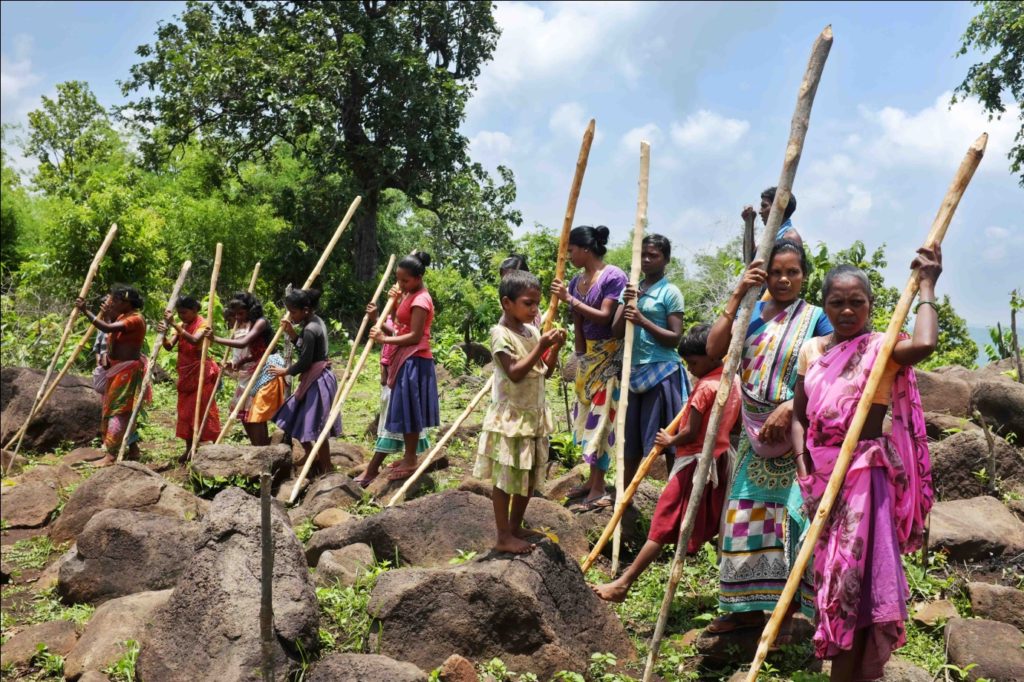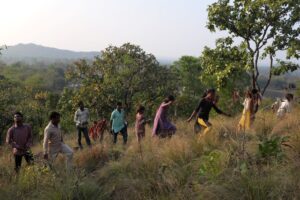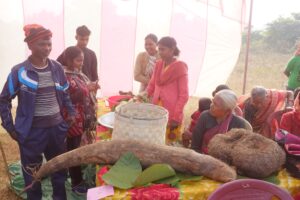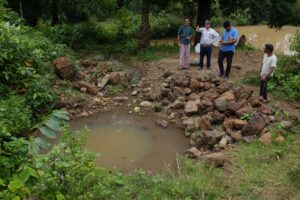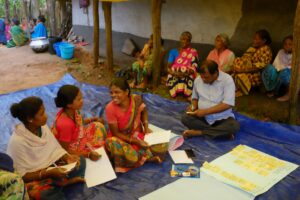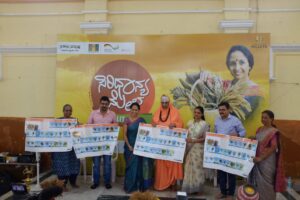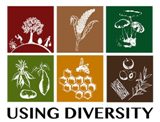The Paharias of Sundar Pahari still continue to follow their traditional agricultural practices on forested hill slopes of the region which involve:
i. Jara cultivation – In August they clear the trees and shrubs in preparation for cultivation. Some valuable trees like Sal and Semul are left to be harvested later. The leaves of cut trees & undergrowth are used as mulch and manure for the pulse crop. After this the barbatti seeds are sown and the crop is harvested in December. Jara involves the cultivation of only barbatti.
ii. Kurva cultivation – After one year of Jara cultivation the same plot is cleared and cleared vegetation is burnt in heaps after kurva cleaning in second year in April – May. Once the Monsoons are in full swing, usually at the end of June or the beginning of July the villagers sow a variety of seeds on the cleared hill slopes. Currently the principal seeds sown under Kurva are Makai, arhar, bajra, sutri and barbatti. Other crops harvested include muto, kudrum, gardi, simbi, bora, batwa, khira, son, jhinga, karela, Noldu and kohda. The crops are then harvested as and when they ripen, usually from end of September to December. After Kurva the land is left fallow for the re-growth of vegetation and trees. While the fallow period varies on average it tends to be 4-5 years. However villagers observed that the fallow period has been declining.
Community Seed Sowing in Tatakpara village –
 On the morning of 29th June we headed to Tatakpara villages to witness sowing activities in the Pradhan Jowahar Paharia’s Kurva fields. Before heading to the fields Jowahar’s wife Budni Paharin treated us to a traditional meal of Makai Bhat (a rice like preparation using powdered Maize), Arhar Dal, Kundri Sabji with local Mango pickle.
On the morning of 29th June we headed to Tatakpara villages to witness sowing activities in the Pradhan Jowahar Paharia’s Kurva fields. Before heading to the fields Jowahar’s wife Budni Paharin treated us to a traditional meal of Makai Bhat (a rice like preparation using powdered Maize), Arhar Dal, Kundri Sabji with local Mango pickle.

We then went to the hillside that was going to be cultivated where we were met by Jowahar’s mother Chandi Paharin some of whose fields were also going to be sown. She was waiting patiently for fellow villagers to arrive for the sowing with two baskets of mixed seeds. One basket contained Makai and Arhar seeds which are sown together and the other comprised Bajra, Sutri and Barbatti seeds which are also sown together.
 The Paharias still practice community cultivation with a large number of villagers from the farmer’s village and neighbouring villages coming together to jointly carry out sowing activities. As we inspected Jowahar’s Kurva plots which had been cleared and burnt in preparation for sowing, we were gradually joined by villagers from Tatakpara, Garsingla and Guttipara who all came armed with 6-8 feet long wooden stakes which they sharpened with the aid of axes and sickles in preparation for sowing.
The Paharias still practice community cultivation with a large number of villagers from the farmer’s village and neighbouring villages coming together to jointly carry out sowing activities. As we inspected Jowahar’s Kurva plots which had been cleared and burnt in preparation for sowing, we were gradually joined by villagers from Tatakpara, Garsingla and Guttipara who all came armed with 6-8 feet long wooden stakes which they sharpened with the aid of axes and sickles in preparation for sowing.
 By 11:30 roughly 60 men, women and children had gathered along with Jowahar and his wife Budni who then commenced distributing seeds which were tied in gamchas, dupattas and sarees.
By 11:30 roughly 60 men, women and children had gathered along with Jowahar and his wife Budni who then commenced distributing seeds which were tied in gamchas, dupattas and sarees.
After all present had received their seeds they lined the hill top armed with their wooden stakes, like an army ready to charge the enemy below. The line comprised women on one side and men on the other and once they had all assumed  their positions atop the hill they commenced their decent.
their positions atop the hill they commenced their decent.
As they descended they used the wooden stakes to make holes in the soil into which they expertly deposited their seeds. One half of the holes were sown with Makai and Arhar and the other with Bajra, Sutri and Barbatti. There was a healthy competition between the men and women, with the men letting out hoots of victory when they were first to reach the base of the hill marking the completion of their sowing tasks. The entire activity was marked by a deep camaraderie and community spirit with villagers greeting each other warmly, sharing local news, teasing and joking with one another while efficiently sowing their quota of seeds.
 With so many experienced hands attacking the task with gusto, all designated fields were sown within one and a half hours. This community sowing is a part of Paharia tradition and at the end of the day the farmer’s family slaughters a pig or a goat which is then divided among those who participated in the sowing. The systems of dividing the meat vary across different Paharia areas and here the pig was going to be sourced from Garsingla village and as per the traditional system of sharing the meat would be divided equally among all those who had partaken in the sowing of the fields.
With so many experienced hands attacking the task with gusto, all designated fields were sown within one and a half hours. This community sowing is a part of Paharia tradition and at the end of the day the farmer’s family slaughters a pig or a goat which is then divided among those who participated in the sowing. The systems of dividing the meat vary across different Paharia areas and here the pig was going to be sourced from Garsingla village and as per the traditional system of sharing the meat would be divided equally among all those who had partaken in the sowing of the fields.
In addition to his own seeds Jowahar also planted some seeds which he had received from the community seed bank set up through the Using Diversity Project. These included traditional varieties that had become scarce or had disappeared completely from these areas like kodme, batwa, muto and gangri.
Bada Palma Village
 In the evening we visited Bada Palma for a seed distribution drive to be carried out by Dharmendra Paharia. We arrived in Bada Palma just in time to witness the distribution of meat from a slaughtered goat to villagers who had just carried out community sowing in one of the villagers Kurva fields. Here the meat was being meticulously weighed and each kilogram of meat was divided into 3 equal portions laid out on Sal leaves with each labourer getting one portion. In addition to the raw meat that everyone took home some meat from everyone’s share was cooked and once again distributed on sal leaves. The broth from cooking the meat was also doled out to all present in ingenious innovated sal leaf bowls. Sadly this rich community tradition is making way for modern more commercial arrangements with a number of farmers preferring to pay the workers in cash rather than in meat.
In the evening we visited Bada Palma for a seed distribution drive to be carried out by Dharmendra Paharia. We arrived in Bada Palma just in time to witness the distribution of meat from a slaughtered goat to villagers who had just carried out community sowing in one of the villagers Kurva fields. Here the meat was being meticulously weighed and each kilogram of meat was divided into 3 equal portions laid out on Sal leaves with each labourer getting one portion. In addition to the raw meat that everyone took home some meat from everyone’s share was cooked and once again distributed on sal leaves. The broth from cooking the meat was also doled out to all present in ingenious innovated sal leaf bowls. Sadly this rich community tradition is making way for modern more commercial arrangements with a number of farmers preferring to pay the workers in cash rather than in meat.
 After the distribution of meat we went to Dharmendra Paharia’s house for the distribution of seeds sourced through the UD project. Surja had given Dharmendra a number of different seeds for distribution to farmers of Bada Palma and neighbouring villages with the purpose of promoting their revival. These seeds had been sourced from different parts of Jharkhand and Chhattisgarh and included kodme, muto, batwa, patge, gangri and a variety of shifting cultivation rice sourced by Soumik. Over 15 men and women from two hamlets of Bada Palma assembled to collect seeds of their choice. They would return double the amount they took after harvesting which would help expand the community seed bank and enable more farmers to benefit from the initiative.
After the distribution of meat we went to Dharmendra Paharia’s house for the distribution of seeds sourced through the UD project. Surja had given Dharmendra a number of different seeds for distribution to farmers of Bada Palma and neighbouring villages with the purpose of promoting their revival. These seeds had been sourced from different parts of Jharkhand and Chhattisgarh and included kodme, muto, batwa, patge, gangri and a variety of shifting cultivation rice sourced by Soumik. Over 15 men and women from two hamlets of Bada Palma assembled to collect seeds of their choice. They would return double the amount they took after harvesting which would help expand the community seed bank and enable more farmers to benefit from the initiative.

